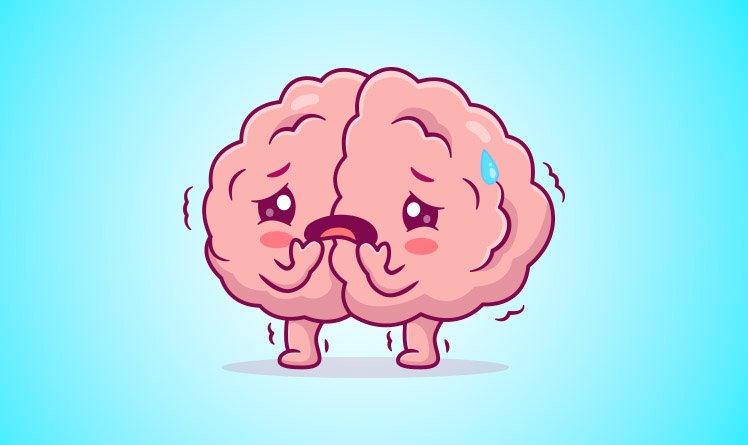Amygdala: How This Tiny Structure Shapes Your Emotions, Fears, and Decisions

|
Getting your Trinity Audio player ready...
|
Have you ever caught yourself overreacting to criticism? Feeling fear even when there was no real danger? Or paralyzed by an important decision? Well, know that perhaps a small but powerful structure in your brain is responsible: the amygdala.
Despite its name resembling the throat, the amygdala has nothing to do with inflammation or surgery. It's a deep emotional center of the brain, essential to how you feel, react, and decide.
In this article, we'll unravel what the amygdala is, how it influences your feelings—especially fear and anxiety—and, most importantly, how you can balance its activity to reprogram your mind.
What is the amygdala and where is it located?
The amygdala (from Latin amygdala, meaning “almond”) is a structure located in an area called limbic system, more specifically in the temporal lobes of the brain. We have two amygdalae, one in each cerebral hemisphere, and their main function is to process emotions, especially fear.
In this way, it is like an internal alarm that detects threats and triggers automatic reactions before you even think rationally about the situation.
“The amygdala is a structure of the limbic system responsible for processing emotions, especially fear, and acts as an alarm that prepares the body to react to real or perceived threats.”
The Function of the Amygdala: Why It Activates Our Fears
Imagine you're walking down the street and see something suddenly move. Before you even realize it's just a cat, your heart races, your muscles tense, and you might even get ready to run. Who did this? The amygdala.
Above all, the amygdala is trained to respond quickly to danger signals. This speed has saved many lives throughout human evolution. However, the problem is that, in the modern world, it continues to react with the same intensity to criticism, rejections, frustrations and even imaginary fears.
In other words, your body reacts as if it were running away from a lion… when, in fact, you just received an email from your boss.
How the Amygdala Influences Our Emotions and Decisions
The amygdala doesn't just trigger fear. It also affects all intense emotions.: anger, joy, sadness, pleasure, and even compassion. This means it plays a role in how we interpret the world, build relationships, and make decisions.
Research shows that decisions made in times of stress (with the amygdala in charge) tend to be impulsive, defensive, and based on past experiences, not what is actually happening.
In other words: when you operate on “emotional autopilot,” it’s probably your amygdala taking the wheel.
Amygdala, limbic system and automatic responses
The amygdala is part of the limbic system, which also includes structures such as the hippocampus (memory) and the hypothalamus (physiological responses). Together, these areas form what is called the emotional brain.
Thus, when the amygdala detects a threatening stimulus, it activates the hypothalamic-pituitary-adrenal axis, releasing cortisol (stress hormone) and adrenaline. This cycle can be useful in real-life situations of danger, but it becomes a problem when it's activated repeatedly in everyday contexts—like a meeting, a difficult conversation, or a comment on social media.
“The limbic system, where the amygdala is located, is responsible for rapid, often automatic, emotional and physiological responses that shape how we react to the environment.”
Overactive Amygdala: What Happens When It Takes Over Your Mind
An overactive amygdala can cause:
- Frequent anxiety attacks
- Irrational fear of judgment
- Feeling of always being on alert
- Difficulty making clear decisions
- Avoidance or procrastination behaviors
This imbalance is common in people with limiting beliefs and histories of emotional trauma, and is often mistaken for an “anxious personality,” when in fact, it is a repeatedly activated brain pattern.
"It's not that you're a weak person. It's your brain trying to protect you. Just in the wrong way."
Tools that help balance the amygdala
Fortunately, the amygdala can be “educated.” That’s right: it’s possible to reconfigure neural connections with techniques that strengthen the prefrontal cortex, the rational part of the brain that regulates emotions.
Some powerful strategies:
- Mindfulness: Studies show that meditation mindfulness reduces the volume of the amygdala and increases the thickness of the prefrontal cortex, creating more emotional balance.
- NLP: Mental reprogramming techniques help reinterpret stimuli that previously triggered fear or anxiety.
- Positive Psychology: Cultivating emotions like gratitude, compassion, and optimism also deactivates the amygdala's alert mode.
Result: you stop being a hostage to emotional reactions and start to have more clarity and autonomy.
Practical techniques to “calm” the amygdala and reprogram the mind
You can get started today with these simple practices:
1. Conscious breathing (4-4-4-4):
Also known as square breathing or box breathing, this breathing technique promotes relaxation and calm. How it works: Inhale slowly through your nose for 4 seconds, filling your lungs. Hold for 4 seconds. Exhale slowly for 4 seconds, releasing all the air from your lungs. Finally, hold (without air) for another 4 seconds. This activates the parasympathetic nervous system and reduces amygdala activity.
2. Name the emotion:
It's a simple yet powerful practice that involves consciously identifying what you're feeling and saying it in words—either mentally or out loud. For example: "I'm angry," "I'm anxious," "I'm scared."
When you name an emotion, you activate areas of the prefrontal cortex. This activation helps inhibit the activity of the amygdala, which is generating the intense emotional reaction.
So, it's like you're telling your brain, "Hey, I noticed what's going on... you can let your guard down."
3. Reframing technique (NLP):
Use the technique of resignification, one of those used in NLP. It involves remembering a negative situation, mentally changing the color, sound, and intensity of the scene. This reprograms the way the memory is recorded and reduces the emotional impact.
Practical example:
Carla always felt humiliated when remembering a criticism she received in public. During an NLP practice, she mentally revisited that memory, but this time transformed the image: she made it black and white, lowered the sound of the critical voice, and shrank the scene until it seemed distant. Thus, what had previously caused a tightness in her chest now seemed merely a neutral memory. She hadn't forgotten what happened. Quite the opposite. But she had lifted the emotional weight of the experience.
4. Body Scan Meditation:
This technique comes from mindfulness and is one of the most effective ways to reduce amygdala activity through mindfulness of the body. Essentially, it involves slowly and intentionally bringing your attention to each part of your body, usually starting with your feet and moving up to the top of your head, or vice versa.
Why does it work?
Because by focusing on your body, you deactivate the alert mode that the amygdala usually activates in moments of mental worry. This shifts your mind's focus from stressful thoughts to the actual physical sensations of the present. Thus, the brain enters a state of perceived security, reducing cortisol and bringing relaxation.
5. Gratitude Journal:
This practice is one of the simplest—and proven effective—ways to reduce amygdala activity. After all, it consists of writing down three things you're grateful for every day. It could be something small, like a hot cup of coffee in the morning, or something big, like a kind gesture from someone special.
Practicing gratitude activates areas of the brain associated with reward, empathy, and well-being, such as the prefrontal cortex and the nucleus accumbens. Consequently, this modulates the activity of the amygdala, decreasing the focus on threats and promoting a more stable emotional state.
Furthermore, it reduces cortisol levels and increases the production of dopamine and serotonin, neurotransmitters linked to pleasure and motivation.
Real Example: Carla's Emotional Journey and Her Amygdala
To reinforce how the amygdala influences our emotions and decisions, let's revisit the story of Carla—a modern, 35-year-old woman curious about self-discovery and tired of feeling stifled by intense emotions.
Carla was always seen as dedicated and competent, but all it took was a difficult conversation or an exposing situation at work to feel a lump in her throat, a racing heart, and thoughts of imminent failure. Most importantly, she didn't understand why she reacted this way, even when the situation was relatively straightforward.
Learning about the amygdala, she realized her brain was programmed to go on high alert whenever she felt the risk of judgment or rejection, even without a real threat. After all, it was her amygdala operating on emotional autopilot, based on past experiences.
Determined to change, Carla began applying small techniques to her daily life:
- In meetings, she mentally named her emotions: “I’m afraid of looking incompetent.” This brought clarity and lessened the impact of anxiety.
- At night, I would scan my body before going to sleep, noticing accumulated tension and gradually relaxing.
- With the practice of NLP, began to reframe uncomfortable memories that previously held her back.
- And, with the gratitude journal, began to build a new narrative about his own life, giving more space to what worked — and not just what hurt.
Within a few weeks, Carla noticed that she still felt fearful and insecure at times—but now she knew exactly what to do when they arose. After all, her amygdala was still there, but she was no longer a hostage to it.
Conclusion: Reprogram your brain to conquer your life with more ease
The amygdala may be small, but its influence is enormous. Therefore, understanding how it works is an essential step to breaking out of autopilot, overcoming self-sabotage, and achieving a life with more lightness, focus, and purpose.
Remember: you don't have to change everything at once. Just start. One step at a time, with awareness, is enough to transform your mental patterns.
Ready to take the next step and take control of your mind?
If you identified with Carla's journey and realized how the amygdala can influence your emotions and decisions, know that this is just the tip of the iceberg.
In the free eBook “Reprogram your Mind: Identify your blocks and begin your transformation”, you will discover:
- How to identify patterns that sabotage your life
- NLP and neuroscience techniques to reprogram your brain
- Practical strategies to cultivate clarity, focus and lightness in everyday life
Download the ebook now and begin your transformation journey with awareness and purpose.
FAQ – Frequently Asked Questions about the Amygdala
1. What is the amygdala?
The amygdala is a brain structure responsible for processing emotions, especially fear, and is located in the limbic system.
2. Can the amygdala cause anxiety?
Yes. When overactive, the amygdala can generate exaggerated fear responses and anxiety attacks.
3. How to reduce amygdala activity?
Practices such as meditation, conscious breathing, NLP, and positive psychology help balance amygdala activity.
4. Is the amygdala related to trauma?
Yes. Emotional trauma intensifies the amygdala's response, making the person more reactive and sensitive to triggers.
5. Is it possible to “reprogram” the amygdala?
Yes. The brain is plastic, and with the right techniques, it's possible to reduce automatic reactions and strengthen emotional control.
Image: Freepik

Marcel Castilho is an expert in neuromarketing, neuroscience, mindfulness and positive psychology. In addition to being an advertiser, he also has a Master's degree in NLP – Neurolinguistic Programming. As the owner and founder of the communications agency VeroCom and also of the digital agency Vero Contents, he has been studying human behavior for over 30 years.


